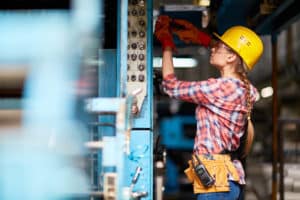About one in three adults has a criminal record, and nearly 450,000 people are released from incarceration each year in the U.S.
An encounter with the justice system presents huge barriers to re-entry, including employment. The unemployment rate for individuals with a criminal record averages 30%, compared with 4.2% for the general population. Individuals who have been incarcerated face a dramatic wage reduction of 51.7%, and even those with a misdemeanor conviction face lower earnings.
The Impact of Positive Employment on Re-Entry
Despite those statistics, there is reason for hope. One study found that the drop in earnings can be reversed within five to nine years after release from incarceration.
Justice-impacted individuals who find and maintain employment after release have a recidivism rate of just 16%, compared to 52% of those who remain jobless. For this reason, second-chance hiring is key to long-term success and reintegration.
Why the Trades Are Ideal for Second-Chance Hiring
Here’s why the trades are a top career choice for individuals to find meaningful, stable employment after a justice encounter.
1. Stable, In-Demand Jobs
Justice-impacted individuals average 3.4 jobs in the first four years after release, suggesting that most jobs they find are unstable or lack opportunities to advance.
The trades are seeing unprecedented job growth coinciding with a critical skills shortage—94% of contractors report difficulty filling skilled positions. This labor gap means that firms are desperate for employees, are willing to train on the job, and will offer long-term employment. Many trades jobs pay above a living wage and offer a fulfilling career path with advancement opportunities.
2. Fast Track to Skilled Employment
Just 6% of incarcerated individuals hold a bachelor’s degree, and 25% lack a high school diploma or GED. A lack of formal education combined with a record makes it very difficult for these individuals to find high-quality jobs.
Many trades require only short on-the-job training or completion of career-readiness training through a workforce development program to get started and don’t require a college degree. The training for high-skill positions like electricians or plumbers is still much shorter and less expensive than a four-year degree, with paid apprenticeships to bridge the gap to a full credential.
3. Opportunities for Self-Employment
While most employers require applicants to disclose if they have a record, making it more difficult for justice-impacted individuals to find standard employment, the trades offer an appealing alternative: working for themselves.
Nearly one in four professionals working in the construction trades is self-employed. There’s a well-established path of learning a trade like HVAC, electrical, or plumbing, then setting up shop offering services directly to homeowners or businesses.
Entrepreneurship has an even stronger positive impact on recidivism than traditional employment. Starting a business helps justice-impacted individuals find financial security, re-integrate into their communities, and build wealth.
Get Started with Training for the Trades
If you’re interested in investing in skill development for justice-impacted individuals, here’s what you should know to get started.
1. Education starts before release
Just as facility residents can work on their GED while incarcerated, they can also work toward a trade. Online training programs enable residents to pursue career exploration and earn industry-recognized credentials like OSHA. The U.S. Chamber of Commerce reports an ROI of $13.21 for every dollar invested in vocational education in correctional facilities.
Through partnerships with Interplay Learning and Orijin, learners can use 3D simulations and virtual reality to acquire the foundations of a skilled trade without a lab or specialized equipment. These in-facility programs make training highly scalable so that waiting lists aren’t a barrier.
2. Engage learners with relevant, engaging materials
Outside of a facility, workforce providers still need to provide engaging, flexible programs for a wide range of learning styles. Today’s learners respond better to experiential learning modes other than textbooks and lectures. Interactive, bite-sized content like videos and simulations helps auditory and kinesthetic learners engage with concepts in multiple ways, while knowledge checks reinforce key points and identify gaps.
Interplay even provides a game-like experience with 3D simulations and leaderboards for motivation.
3. Embrace virtual training
While working on live equipment is eventually a part of every technician’s journey, training in a virtual environment is still incredibly powerful. One study by UCLA shows that students training virtually were more effective than their colleagues who trained in traditional settings. Virtual learning enables justice-impacted individuals to overcome barriers like transportation and childcare in their post-release learning journey. It also makes it easier to implement pre-release vocational training, as facilities may be limited by space and safety regulations.
Second-chance hiring isn’t just a social good. It’s a smart workforce development strategy. Skill development in the trades offers justice-impacted individuals a clear and attainable path to meaningful employment and financial stability. By investing in training for the skilled trades, you’re not only reducing recidivism, you’re unlocking human potential.
If your organization is ready to support skill development and career pathways for justice-impacted individuals, Interplay Learning is here to help. Our virtual training platform brings scalable, hands-on learning to wherever your learners are.
Contact us today to learn how you can bring high-impact training to your program and empower people with tools to build a better future.




